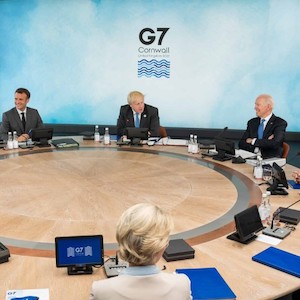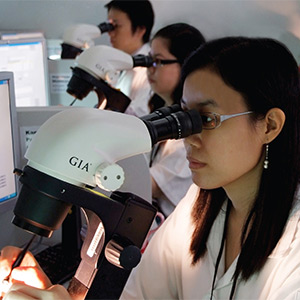
G7 representatives have spent the last year crafting sanctions on Russian diamonds, with the hope that all member countries would enact the same requirements. But it hasn’t worked out that way.
One thing is the same: On March 1, every G7 nation—the United States, the United Kingdom, Canada, Japan, France, Germany, Italy—and the European Union (a “non-enumerated” member of the G7) banned the import of loose Russian-mined diamonds 1 ct. and up, even if they were cut and polished elsewhere.
But there are major differences in how each country is asking traders to prove they’re not shipping sanctioned goods. Depending on where you import, you may have to supply a lot of evidence or none at all.
The United States has opted for self-certification—importers are required to supply a statement on company letterhead confirming their shipment contains no Russian diamonds, per new Customs and Border Protection (CBP) rules. For importers of diamond jewelry, the statement need only affirm that no diamonds in the jewelry were exported directly from Russia—which seems to allow for mounted stones that were mined in Russia but cut and polished elsewhere.
For now, the U.S. isn’t requiring backup for these statements. But Sara Yood, deputy general counsel of the Jewelers Vigilance Committee, recommends that importers “have it available in case of further examination of parcels.”
The CBP guidance contains no information on how importers should handle old or recycled goods.
The European Union’s guidelines on Russian diamonds are stricter than the U.S.’s, mandating that importers provide origin information for all diamonds 1 ct. and larger. Rough diamond importers will need to supply a single-origin Kimberley Process certificate. (Mixed parcels won’t be allowed, though De Beers’ “Botswana sort” will qualify as single-origin even though it aggregates production from four countries.) Customs agents may ask for additional paperwork, including a declaration form, invoice, packing list, and transportation documentation.
Importers of polished stones must provide a declaration that none of their diamonds were mined in Russia, along with proof—which could include a Customs form, invoice, packing list, transportation documentation, evidence from traceability systems, or a lab grading report (such reports typically do not contain origin information, but they can be used in combination with documents that do).
The United Kingdom’s policy seems to mix the U.S. and EU approaches. A notice from the U.K. Department of Business & Trade said self-certification “may” be acceptable, but added that “importers should be prepared to provide further evidence retrospectively if required, including to demonstrate that the goods are not of Russian origin or above the weight limit.”
The U.K. has also issued a “general trade license” for non-Russian goods that were manufactured outside Russia before March 1.
“Traders should be prepared to have documentation available to demonstrate evidence of a processed diamond’s location,” said a page outlining the license. “This does not need to demonstrate the precise date of manufacture itself, but that the goods existed and were located outside of Russia before [March]. Examples of evidence could include an invoice, bill of lading, sales contract, or original [Kimberley Process certificate].”
The license can also be used for goods with unknown provenance, as long as there’s evidence they were purchased outside of Russia prior to March 1.
Canada and Japan also enacted bans on Russian polished, but their statements contained few specifics on enforcement.
All current rules govern only the “sunrise period,” which is supposed to end Aug. 31. Starting in September, the size threshold may drop to half a carat, and diamonds will be required to have a G7 certificate. (Last week, Everledger CEO Leanne Kemp, who is helping to develop the G7 certification system, announced on LinkedIn that the first certificates had been issued, part of a pilot with select manufacturers and miners.)
The G7 program could mean, at least initially, that all diamonds of at least half a carat will need to be routed through Belgium, where the certification scheme will be headquartered. There are two possible exceptions: Canada plans to install its own “rough node,” which will certify production from that country’s mines, and any “beneficiated” goods—diamonds polished in the same country where they were mined—will be allowed to circumvent certification.
The JVC has added a “sanctions resources” page on its website.
(Photo courtesy of the White House)
- Subscribe to the JCK News Daily
- Subscribe to the JCK Special Report
- Follow JCK on Instagram: @jckmagazine
- Follow JCK on X: @jckmagazine
- Follow JCK on Facebook: @jckmagazine







